
Lamma Island, also known as Y Island or Pok Liu Chau or simply Pok Liu, is the third largest island in Hong Kong. Administratively, it is part of the Islands District.

The Islands District is one of the 18 districts of Hong Kong. It is part of the New Territories. It had a population of 170,900 in 2018.

Tung Chung, meaning "eastern stream", is an area on the northwestern coast of Lantau Island, Hong Kong. One of the most recent new towns, it was formerly a rural fishing village beside Tung Chung Bay, and along the delta and lower courses of Tung Chung River and Ma Wan Chung in the north-western coast of Lantau Island. The area was once an important defence stronghold against pirates and foreign military during the Ming and the Qing dynasties.

Chek Lap Kok is an island in the western waters of Hong Kong's New Territories. Unlike the smaller Lam Chau, it was only partially leveled when it was assimilated via land reclamation into the 12.48 square kilometres (4.82 sq mi) island for the current Hong Kong International Airport, which opened for commercial aviation in 1998. The airport is popularly referred to as Chek Lap Kok Airport to distinguish it from the former Hong Kong International Airport, now commonly known as Kai Tak Airport (啟德機場).
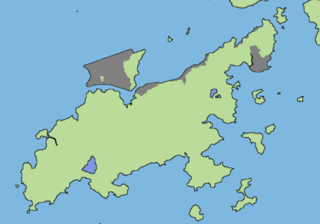
Lam Chau was an island in Hong Kong. It was one of the two original islands that made up the site of the current Hong Kong International Airport.

Out of the total 1,092 km2 land in Hong Kong, three-quarters is countryside, with various landscapes including beaches, woodlands, and mountain ranges being found within the small territory. Most of Hong Kong's parks have abundant natural diversity, usually containing over 1,000 species of plants.
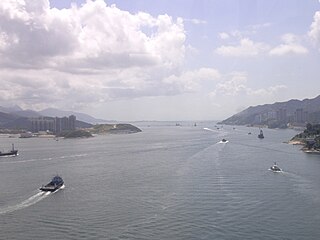
Urmston Road is a broad body of water between Lantau Island and Tuen Mun in Hong Kong. It forms an inshore passage between the northwest end of Victoria Harbour and the mouth of the Pearl River. At its eastern end it connects to the Western Working Anchorage through the Ma Wan Channel and the narrower Kap Shui Mun channel to the west of Ma Wan.

North Lantau Highway is an expressway forming part of Hong Kong's Route 8, linking Hong Kong International Airport and Lantau Island with the rest of the territory. The road has three lanes in each direction for its entire length with full-width hard shoulders for emergencies and breakdowns. The speed limit is 110 kilometres per hour (68 mph) for most of its length, the highest of any road in Hong Kong.
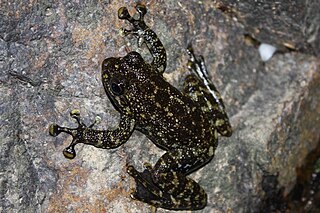
Hong Kong cascade frog or Hong Kong torrent frog is a species of true frog from southern coastal China, once thought to be endemic to Hong Kong. Their eggs are laid on rock faces in the splash zones of cascades. In Hong Kong, it is a protected species under Wild Animals Protection Ordinance Cap 170.

Boulenophrys brachykolos, the short-legged horned toad or Peak spadefoot toad, is a frog native to southern China and Vietnam. It was first discovered in the Victoria Peak, Hong Kong. Many populations of Hong Kong are in the country parks, such as Lung Fu Shan Country Park.

The greenhouse frog is a species of frog in the family Eleutherodactylidae, native to Cuba, the Bahamas, and the Cayman Islands, and it has been introduced to other areas, such as Florida, Hawaii, Guam, Hong Kong and Shenzhen.
Philautus ingeri is a species of frog in the family Rhacophoridae. It is endemic to northern Borneo and found in Sabah, Sarawak, Brunei, and adjacent northern Kalimantan (Indonesia). Common names Inger's bush frog and Inger's bubble-nest frog have been coined for it. It is named for Robert F. Inger, American zoologist from the Field Museum of Natural History.
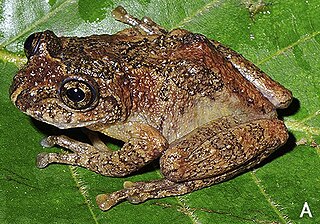
Nasutixalus jerdonii is a species of frog in the family Rhacophoridae. It is found in the northeastern India, in the West Bengal, Nagaland, Manipur, and Meghalaya states. It range might extend into the adjacent Nepal. The specific name jerdonii honours Thomas C. Jerdon, an English herpetologist. Common names Jerdon's bubble-nest frog, Jerdon's tree frog, and Jerdon's bush frog have been coined for this species.

Polypedates macrotis, commonly known as the dark-eared treefrog, sometimes also Bongao tree frog, Bongao bubble-nest frog, Baram whipping frog, or brown-striped tree frog, is a species of frog in the family Rhacophoridae. It is found in the central peninsular Thailand, Sumatra, Borneo, and Sulu Archipelago as well as a range of other Philippine islands.
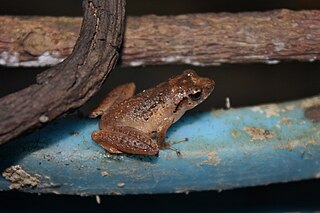
Liuixalus is a small genus of rhacophorid frogs that are distributed in southern China. Some species now in Romerus were originally placed in Philautus. It is thought to be the most basal genus in the Rhacophorinae.

The Tuen Mun–Chek Lap Kok Link is a road project in the New Territories, Hong Kong. It comprises two elements: the "Northern Connection" and the "Southern Connection". The Northern Connection comprises an undersea tunnel crossing the Urmston Road, linking Tuen Mun to the "Boundary Crossing Facilities" (BCF), an artificial peninsula connected to Hong Kong International Airport. The Southern Connection, officially named Shun Long Road, comprises viaducts linking the BCF to North Lantau Highway on Lantau Island.

Scenic Hill is a hill on Chek Lap Kok, Hong Kong, and stands at a height of 77 metres (253 ft) above the sea level. Today, Scenic Hill is the tallest point on Chek Lap Kok Island, which houses Hong Kong International Airport. In the 1990s, taller nearby mountains on Chek Lap Kok Island were bulldozed to make reclaimed-land for the airport.
















